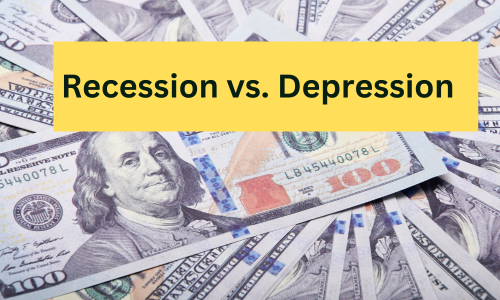This site may contain links to affiliate websites, and I may earn a commission for any purchases made through those links at no additional cost to you.

Recession vs. Depression: Understanding the Difference and Preparing Your Finances
The economy naturally experiences ups and downs. Two terms that often surface during economic downturns are “recession” and “depression.” While both signify economic decline, they aren’t the same. Understanding the nuances between them is crucial for navigating your financial future.
What is a Recession?
A recession is a significant decline in economic activity spread across the economy, usually lasting more than a few months. Key indicators of a recession include:
-Rising Unemployment: More people are out of work.
-Falling GDP: The country’s gross domestic product decreases.
-Decreased Consumer Spending: People are buying less.
What Causes a Recession?
Several factors can trigger a recession:
-Overheated Economy: Rapid growth leads to high demand that manufacturers can’t meet, causing inflation. The Federal Reserve may then raise interest rates to curb demand.
-Financial Bubbles: When asset prices rise unsustainably (like the housing bubble), the bubble can burst, triggering a recession.
-Economic Shocks: Unexpected events like the 2008 financial crisis or the COVID-19 pandemic can severely disrupt the economy.
Signs a Recession May Be Coming:
-Falling GDP: A consistent decline indicates weakening demand and production.
-Inflation: Businesses may raise prices and cut production in response to higher costs.
-High Unemployment: Companies may reduce their workforce due to higher prices.
-Stock Market Declines: Significant drops can signal economic trouble (though not always).
Impact of a Recession:
-Higher Prices: Everyday goods may become more expensive.
-Manufacturing Declines: Businesses cut back on production.
-Job Insecurity: Layoffs become more common.
-Wage Stagnation: Earnings may not increase as quickly.
Recessions are Temporary
It’s important to remember that recessions are a normal part of the economic cycle and don’t last forever. Since 1980, the U.S. has experienced six recessions. The average recession from 1854 to 2020 lasted 17 months according to the NBER.
What is a Depression?
A depression represents a more intense and enduring economic decline compared to a recession.
It is characterized by a drastic decline in economic activity. The Great Depression was the most significant example in U.S. history.
Causes of a Depression:
The Great Depression was triggered by factors like:
-Rising consumer debt
-Decreased consumer demand
-A slump in industrial production
-The Stock Market Crash of 1929
Signs of a Depression:
-Extremely high unemployment
-Devaluation of assets
-Consumers defaulting on debts
Impact of a Depression:
Depressions can be devastating:
-Significant drop in GDP
-Extremely high unemployment rates
-Banking system failures
-Loss of jobs, savings, and homes
Depressions are Rare
Fortunately, depressions are much rarer than recessions. The Great Depression, which lasted from 1929 to 1941, is the only one the U.S. has experienced.
Preparing Your Finances for Economic Downturns
Whether it’s a recession or a depression, preparing your finances is crucial. Here’s how:
-Build Your Emergency Fund: Aim for three to six months’ worth of expenses in a readily accessible savings account.
-Pay Down High-Interest Debt: Reducing your debt burden can provide more financial flexibility.
-Revisit Your Budget: Cut unnecessary expenses to free up cash.
-Focus on Your Career: Sharpen your skills, network, and seek opportunities for advancement.
Investing During Economic Slumps:
-Dollar-Cost Averaging: Invest a consistent amount at regular intervals, unaffected by market fluctuations.
-Dividend-Producing Stocks: These can provide income even when the market is down.
-Diversify Your Portfolio: Distribute your investments across a variety of asset classes to minimize risk and enhance stability.
Key Differences: Recession vs. Depression
| Feature | Recession | Depression |
|---|
| Duration | Typically a few months to a couple of years | Can last for many years |
| Frequency | More common | Rare |
| Impact | Disruptive, but temporary | Devastating and long-lasting |
| Price Changes | Rising prices often accompany recessions | Falling prices (deflation) during depressions |
Staying Informed and Prepared
While economic downturns can be unsettling, understanding the difference between a recession and a depression can empower you to make informed financial decisions. By taking proactive steps to prepare your finances, you can weather economic storms and position yourself for long-term success.




